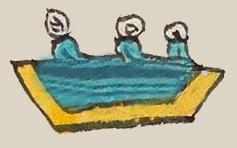apantli (Mdz13v)
This element has been carved from the compound sign for the place name, Coyolapan (see below). It is a cross-section view of the canal, with its yellow liner and trapezoidal shape, both suggesting some degree of construction meant to contain the water, which is a turquoise blue with black lines of varying thickness that suggest current or flow (movement). Splashing off the top of the water are two droplets and a turbinate shell, classic emblems of water in Nahua hieroglyphics.
Stephanie Wood
The apantli glyph or element can have a wide range of color combinations for the lining around the water, while the representation of the water remains much the same (but with or without the splashes coming off the top). The lining can be a single color (red, yellow, or green), or it can be two or three colors.
Stephanie Wood
c. 1541, but by 1553 at the latest
Stephanie Wood
water, shells

apan(tli), water channel or canal, https://nahuatl.wired-humanities.org/content/apantli
pan(tli), furrow, https://nahuatl.wired-humanities.org/content/pantli
-apan (locative suffix), on the water, https://nahuatl.wired-humanities.org/content/apan-0
a(tl), water, https://nahuatl.wired-humanities.org/content/atl
-pan (locative suffix), on, https://nahuatl.wired-humanities.org/content/pan
water channel
el canal, la orilla del agua
Stephanie Wood
Codex Mendoza, folio 13 verso, https://digital.bodleian.ox.ac.uk/objects/2fea788e-2aa2-4f08-b6d9-648c00..., image 37 of 188.
The Bodleian Libraries, University of Oxford, hold the original manuscript, the MS. Arch. Selden. A. 1. This image is published here under the UK Creative Commons, “Attribution-NonCommercial-ShareAlike 3.0 License” (CC-BY-NC-SA 3.0).



